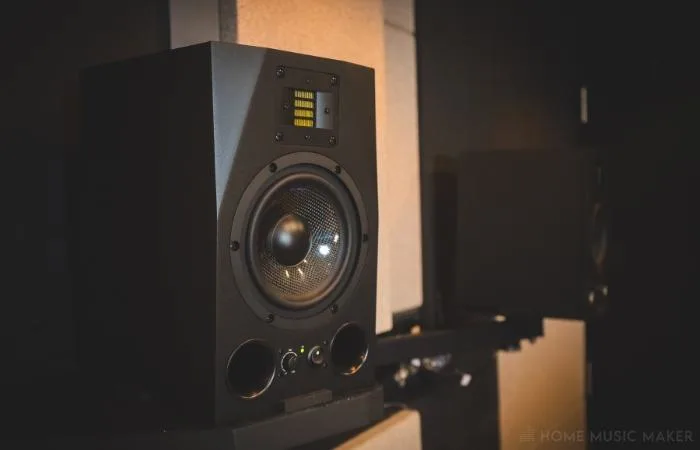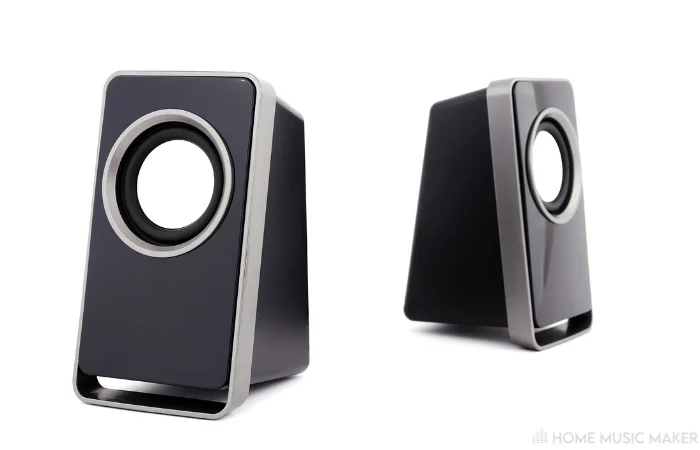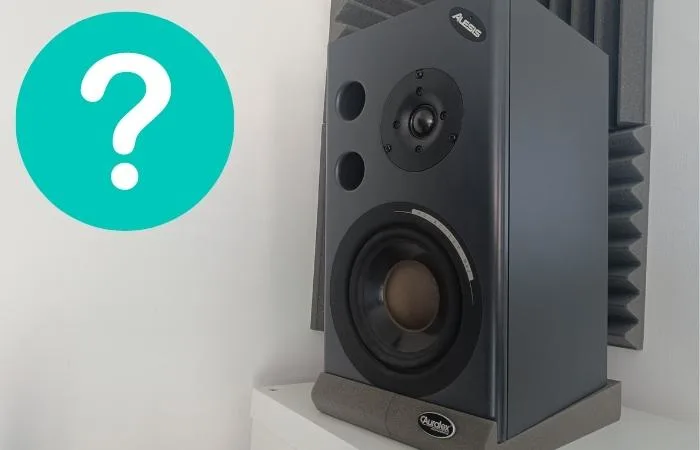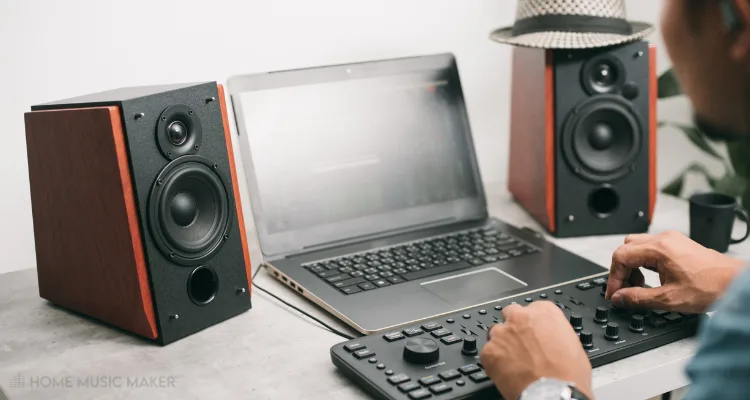KEY TAKEAWAYS:
The main difference between computer speakers and studio monitors is that Computer speakers are cheaper and are made to work with a computer for entertainment purposes. Studio monitors are more expensive, have a flatter frequency response, and are made to work in a studio environment and aid in music production.
Studio Monitors Vs. Computer Speakers
Since the advent of computer music production, many people have started using their computers to record and produce music.
When it comes to sound, everyone has an opinion about which speaker type is the best. Some swear by studio monitors, while others swear at them.
Today we’re going to settle the debate once and for all.
By comparing studio monitors and computer speakers side by side, you can figure out which speaker type is the best for your needs!
Let’s dive into this head-to-head comparison and see which is on top.

What Are Studio Monitors?
Studio monitors are speakers designed for use in a recording studio.
A typical studio monitor is usually an open-back design.
The back of the speaker cabinet has a cover with a grill cloth to allow sound to escape.
The cloth provides acoustic coupling between the inside of the cabinet and the surrounding room.

They also come in two distinct categories:
- Active monitors have an amplifier built into the cabinet.
- Passive speakers need an external amplifier.
The drivers used in most studio monitors produce a flat frequency response.
Meaning they have minimal coloration from one frequency range to another.
They also have high sensitivity so they can play loudly even with low-power amplifiers.
They are also easily bi-amped or tri-amped using different amplifiers for lows, mids, and highs.
Studio monitors give an accurate sonic representation of what is being played on them without adding any extra coloration.
READ NEXT:
Unsure what kind of speaker you need? Check out our article on whether studio monitors are necessary.
What Are Computer Speakers?
Computer speakers are a type of speaker used with computers. They connect to the computer through a USB or 3.5mm jack on the back. Or by using an auxiliary input on your sound card.

Most of these speakers have a power button on them. But it is possible to connect and power them through your computer’s power supply. They do not need to plug into an outlet because they draw their power from the laptop.
The size range for computer speakers is about 8 inches to 18 inches in diameter. And most people choose a size based on the space available in their room. The average size would be 12 inches, providing great audio without taking up too much room.
These speakers usually come with acoustic tuning controls like bass and treble knobs.
They also feature volume buttons so you can tweak them according to your preferences.
Some include features like headphones for private listening, phone jacks for hands-free chatting, or even DSP settings so you can adjust your audio.
The main difference between studio monitors and computer speakers is that studio monitors produce the most accurate reproduction of sound possible.
They’re built to take advantage of the natural acoustic properties of a room, which means that they can deliver a much more true-to-life listening experience.
This means that they often sacrifice sound quality for features like portability and ease of use.
Many professionals will choose studio monitors over computer speakers because they offer a better balance of sonic accuracy and usability.
Are There Any Similarities Between Studio Monitors And Computer Speakers?
Computer speakers and studio monitors are both speaker systems. They play sound from a computer or other device.
The main difference is that studio monitors are designed for audio production. At the same time, computer speakers will generally be used for playing music. Other than this, they’re similar in some ways.
They’re both powered by electricity and have a woofer and a tweeter.
They must also be hooked up to a power outlet and external hardware. For instance, a computer speaker would need to be plugged into the laptop or desktop it’s being played on. At the same time, a studio monitor would require being hooked up to an amplifier or mixer before turning it on.
Can You Use Studio Monitors As Computer Speakers?
The answer to this question is yes and no. If the monitors you want to use are passive, then it’s a no, but if they are active, it’s a yes… kind of.

Studio monitors are used in a recording studio environment. They generally don’t have input jacks that will work with your computer.
You can get around this by using an adapter cable. Adapter cables convert one type of jack to another kind.
For example, we are converting a standard 3.5mm TRS headphone jack to a 1/4 inch TRS jack. Another way would be to use a USB audio interface that already has 1/4-inch jacks on it.
From there, you should be able to go directly into your active studio monitors.
Can You Use Computer Speakers As Studio Monitors?
Although computer speakers are not the ideal way to mix audio, they can be used as studio monitors if you are on a budget.
The main reason is that studio monitors are designed to have a flat frequency response. This means that no frequency is considerably louder or quieter than the rest.
They call it flat because if you plot a graph of the frequency vs. peak DB level, ideally, it would be a flat horizontal line. If a speaker has any peaks or valleys in the frequency curve, it’s considered “colored” and not flat.
That is why most professionals use monitors to mix. Studio monitors are designed for mixing, so you won’t get any peaks or dips in your mix that aren’t supposed to be there.
You could use computer speakers as studio monitors. But they are not flat and will introduce peaks into your mixes, which must be corrected later in mastering.
The benefit of using computer speakers as studio monitors is that they can be used in a pinch. Or when your budget doesn’t allow for actual studio monitors.
Can You Produce And Mix With Computer Speakers?
You can produce and mix with computer speakers, but there are better ideas than this. You can make do with them if you’re starting, but we recommend upgrading as soon as possible. Studio monitors are a better choice.
They have a flat frequency response, which is essential for mixing audio tracks.
They also give you a more accurate representation of what the finished product will sound like.
Plus, studio monitors handle much louder volumes than computer speakers.
You’ll get more precise mixes at lower levels on your studio monitor system. The upfront cost may be higher. But you’ll save money in the long run by purchasing high-quality gear right from the start.
Should You Use Studio Monitors Or Computer Speakers For Music Production?
The most significant difference between studio monitors and computer speakers is the size of their drivers. Studio monitors have a much more powerful driver. Which means they can play lower frequencies at higher volumes than computer speakers.

This makes them better for music production purposes, as you’ll be able to mix them with greater detail.
But many people like to use studio monitors for monitoring. And use a set of computer speakers for mixing on the go – because they’re more portable. For this reason, there’s nothing wrong with getting either one. It all depends on your preferences and budget.
If you don’t mind spending money on a pair of studio monitors, it would be worth it in the long run.
A good quality set of studio monitors will cost anywhere from $300 to $600 or more. At the same time, a good quality set of computer speakers will cost $100 to $300 or more.
Remember that depending on what type of soundcard your desktop or laptop has, you may need an external sound card to make up for its limitations.
In a perfect world, it would be good to have both. Most people consider it good practice to mix with studio monitors. And then, as a final step, check that it sounds good on computer speakers too.
If you are new to music production, buying both types is not feasible. If this is the case, do your best with what you have now.
But when you can, buying a set of studio monitors would benefit your overall workflow and give you better-sounding mixes down the line!
READ NEXT:
To get the most out of your studio monitors, check out our article on choosing the right monitor cables.
Studio Monitors Vs. Computer Speakers For Gaming
Studio monitors and computer speakers are two different types of audio equipment. Studio monitors are used in professional studios to produce high-quality sound.
While computer speakers are used as secondary devices for gaming.
You will want computer speakers if you’re looking for a more immersive experience when playing games on your PC. Many people will not even like the sound of studio monitors. Since, generally, a flat response doesn’t sound “good”, it sounds accurate.
When listening for entertainment, you will enjoy a colored sound much more.
Such as what you would get from computer speakers.
Related Questions
Do Studio Monitors Look Different from Computer Speakers?
On a basic level, no. They will be rectangular enclosures with one or more speaker cones visible on the front or hidden behind a mesh grill.
But in subtle ways, yes, there are some differences.
The easiest way to know for sure would be to check the rear panel and identify what type of audio connections it has. Suppose you see either an XLR connector or a ¼ inch TS (such as on an electric guitar). In that case, you will know it is probably studio equipment.
Another way to tell is to look at the size and brand. Computer speakers tend to be smaller. And suppose a brand like Logitech or Creative Labs makes them. In that case, you will know they are computer speakers (or home theater speakers, but most importantly, not studio monitors.
Where Do Studio Monitors Go in A Rectangular Room?
Distortions can be caused by the sound reflecting off perpendicular walls(side wall reflection). To avoid this, set up the speakers along one of the longer walls.
Position them ~12 inches from the wall behind them and symmetrical with the middle of the room.
They should be the same distance from your listening position(aim for an equilateral triangle between you and the two monitors). And angled inward towards the listening position.
The tweeters should be level with your ears. If the monitors are oriented horizontally, you want the tweeters to be on the outside so that one speaker mirrors the other.
For Home Recording, Should I Use Studio Monitors or Desktop Speakers?
It would be best if you use studio monitors.
Should Studio Monitors Be Angled or Straight?
Studio monitors should be symmetrical and inward, pointing towards the listening position.
What Is the Most Popular Studio Monitor?
The Yamaha HS5 and the KRK Rokit series are popular studio monitor models. They are easily identifiable by their prominent white and yellow speaker cones, respectively.
Final Words
While both speaker types are similar on a fundamental level, they are made to serve two very different purposes.
That being said, it is certainly possible to produce music with pc speakers. But ideally, it is better to use studio monitors.
READ NEXT:
In the market for studio monitors? Check out our review of the KRK Rokit G4 studio monitors.

 Want to connect with other music producers for help and guidance?
Want to connect with other music producers for help and guidance?